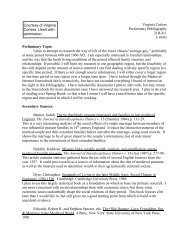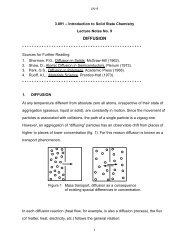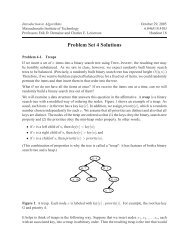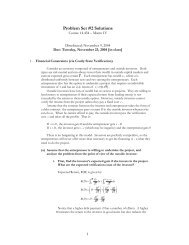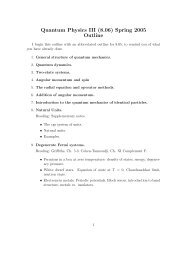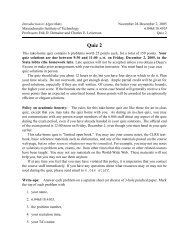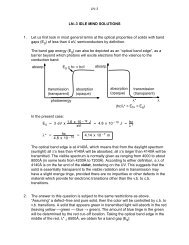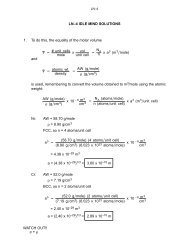Using Foreign Languages in the Middle Ages
Using Foreign Languages in the Middle Ages
Using Foreign Languages in the Middle Ages
You also want an ePaper? Increase the reach of your titles
YUMPU automatically turns print PDFs into web optimized ePapers that Google loves.
21H.411<br />
12/9/04<br />
<strong>Us<strong>in</strong>g</strong> <strong>Foreign</strong> <strong>Languages</strong> <strong>in</strong> <strong>the</strong> <strong>Middle</strong> <strong>Ages</strong><br />
Introduction<br />
Over <strong>the</strong> past few decades, historians have signf<strong>in</strong>cantly broadened <strong>the</strong>ir outlook on <strong>the</strong> past.<br />
The growth of social, cultural, and economic history brought categories such as class, gender,<br />
race, culture, and quantitative analyses <strong>in</strong>to <strong>the</strong> ma<strong>in</strong>stream of historical work. Optimists<br />
credit new approaches with historians’ richer understand<strong>in</strong>g of <strong>the</strong> past, pessimists blame<br />
<strong>the</strong>m for <strong>the</strong> fragmentation of <strong>the</strong> historical profession, but none would deny that <strong>the</strong>y are<br />
<strong>the</strong> driv<strong>in</strong>g force beh<strong>in</strong>d much recent productive historical work, not least because <strong>the</strong>y spur<br />
<strong>the</strong> <strong>in</strong>corporation of approaches from o<strong>the</strong>r social sciences.<br />
In this ve<strong>in</strong>, some social historians have begun to <strong>in</strong>vestigate <strong>the</strong> “social history of lan<br />
guage.” 1 As language is studied from many viewpo<strong>in</strong>ts, <strong>the</strong> perspectives of l<strong>in</strong>guists, literary<br />
scholars, ethnographers, and so on are relevant to its role <strong>in</strong> history. This holds especially<br />
true for <strong>the</strong> <strong>Middle</strong> <strong>Ages</strong>. Few medieval historians have focused exclusively on language,<br />
perhaps <strong>in</strong> part because of <strong>the</strong> <strong>in</strong>tense <strong>in</strong>terest of philologers and literary scholars <strong>in</strong> <strong>the</strong><br />
1Most prom<strong>in</strong>ently Peter Burke. i.e. Peter Burke, Roy Porter, eds. The Social History of Language<br />
Cambridge: Cambridge University Press, 1987.<br />
1
period. This essay is a sketch of <strong>the</strong> place of foreign languages <strong>in</strong> medieval societies of West<br />
ern Europe, from late Antiquity to around 1300. Because Lat<strong>in</strong> <strong>in</strong> medieval societies was<br />
ubiquitous and has been (justifiably) wellstudied, discussion of it is <strong>in</strong>tentionally limited<br />
here to its social uses. In contrast to a picture of static Lat<strong>in</strong>vernacular diglossia, languages<br />
and <strong>the</strong>ir social mean<strong>in</strong>gs changed drastically dur<strong>in</strong>g this period. <strong>Languages</strong> were learned<br />
and used for practical purposes or as tools of social power, and almost never for scholarly<br />
purposes or <strong>in</strong>tellectual enrichment, as <strong>the</strong>y would be from <strong>the</strong> Renaissance on.<br />
Mutual Understand<strong>in</strong>g<br />
Conquests, colonization, and settlements took place frequently dur<strong>in</strong>g <strong>the</strong> <strong>Middle</strong> <strong>Ages</strong> – how<br />
did groups of people speak<strong>in</strong>g different languages communicate with each o<strong>the</strong>r? In a given<br />
situation, four options are possible. If <strong>the</strong> groups had relatively little contact, <strong>in</strong>terpreters<br />
could have been used. The languages spoken by both groups could have been sufficiently<br />
mutually <strong>in</strong>telligible. Or both languages could have been used <strong>in</strong> <strong>the</strong> society shared by <strong>the</strong><br />
groups. Sociol<strong>in</strong>guists have found that all societies have strict codes for which language (or<br />
form of a language) can be used <strong>in</strong> a given situation. A society where two languages are used<br />
<strong>in</strong> different situations and tend to re<strong>in</strong>force a power dynamic is called diglossic. Without <strong>the</strong><br />
power dynamic, <strong>the</strong> society is called bil<strong>in</strong>gual. Exclud<strong>in</strong>g Lat<strong>in</strong>/vernacular diglossia, several<br />
examples show that multil<strong>in</strong>gual societies before 1300 were more bil<strong>in</strong>gual than diglossic.<br />
Vik<strong>in</strong>g Age England (c. 7901066) was home to two peoples speak<strong>in</strong>g two languages,<br />
2
2 Old English and Old Norse. Historians have long debated <strong>the</strong> extent to which English<br />
and Norse speakers <strong>in</strong>teracted, but careful studies of <strong>the</strong> l<strong>in</strong>guistic situation are relatively<br />
recent. Mat<strong>the</strong>w Townend analyzed onomastic (name) evidence, contemporary AngloSaxon<br />
sources, and Norse sagas (which took place dur<strong>in</strong>g this period, but were not written down<br />
until <strong>the</strong> 14th century) for <strong>in</strong>formation on NorseEnglish relations. He argues for “a situation<br />
3<br />
of adequate mutual <strong>in</strong>telligibility between speakers of Norse and English <strong>in</strong> <strong>the</strong> Vik<strong>in</strong>g Age”<br />
– <strong>the</strong> phonological systems of <strong>the</strong> two languages were similar enough that speakers of one<br />
language could learn to understand words spoken <strong>in</strong> <strong>the</strong> o<strong>the</strong>r. In this view, supported<br />
4 by archaeological evidence, Vik<strong>in</strong>g Age England was a divided society. Bil<strong>in</strong>gualism was<br />
societal, but not <strong>in</strong>dividual – <strong>the</strong> two groups rema<strong>in</strong>ed largely separate and spoke different<br />
languages, although each language had uses common to both races. Old Norse was <strong>the</strong> court<br />
and adm<strong>in</strong>istrative language of Scand<strong>in</strong>avian rulers of England, such as Canute (10161035).<br />
Bards from AngloSaxon and Old Norse poetic traditions competed at court, and had some<br />
familiarity with each o<strong>the</strong>r’s repertoire. All writ<strong>in</strong>g had to be done <strong>in</strong> Lat<strong>in</strong> or AngloSaxon,<br />
s<strong>in</strong>ce Old Norse was not yet written. When Old Norse disappeared from England <strong>in</strong> <strong>the</strong> 11th<br />
century, it left beh<strong>in</strong>d a wealth of place names, but little o<strong>the</strong>r residue on English, a typical<br />
5<br />
pattern <strong>in</strong> societies with little contact between conquer<strong>in</strong>g and conquered peoples.<br />
At least one author has argued for mutual <strong>in</strong>telligibility among most Germanic languages<br />
2Nei<strong>the</strong>r language was completely standardized at this po<strong>in</strong>t, but <strong>the</strong> different English dialects were much<br />
more similar to each o<strong>the</strong>r than to Scand<strong>in</strong>avian ones, and vice versa. The same holds true for most pairs<br />
of languages <strong>in</strong> this essay.<br />
3Townend (2002), p. 182.<br />
4Bibere (2001) also supports this view.<br />
5Townend (2002), Chs. 1, 6.<br />
3
6 <strong>in</strong> <strong>the</strong> Early <strong>Middle</strong> <strong>Ages</strong>. In support of this view, E<strong>in</strong>hard writes <strong>in</strong> <strong>the</strong> 9th century that<br />
“all <strong>the</strong> rough and uncivilized peoples <strong>in</strong>habit<strong>in</strong>g Germany between <strong>the</strong> Rh<strong>in</strong>e and Vistula<br />
rivers, <strong>the</strong> ocean and <strong>the</strong> Danube... almost all speak a similar language.” Some exceptions<br />
must be made – he also writes that when a group of Frisians asked Charlemagne to send <strong>the</strong>m<br />
an emissary to expla<strong>in</strong> Christian doctr<strong>in</strong>e, Charlemagne sent a Frisian, imply<strong>in</strong>g that a Frank<br />
7 would not have been understood. Similarly, Richard Wright has argued for panRomance<br />
comprehension across <strong>the</strong> former Roman world well <strong>in</strong>to <strong>the</strong> 10th century, po<strong>in</strong>t<strong>in</strong>g out that<br />
8<br />
”<strong>the</strong>re is never a sign of a need, <strong>in</strong> <strong>the</strong> early <strong>Middle</strong> <strong>Ages</strong>, for <strong>in</strong>traromance <strong>in</strong>terpreters.”<br />
Although such proofs rest uncomfortably on reason<strong>in</strong>g from negative evidence, largescale<br />
mutual comprehension would have facilitated <strong>the</strong> shift<strong>in</strong>g political alliances characteristic of<br />
different tribes <strong>in</strong> late antiquity and <strong>the</strong> early <strong>Middle</strong> <strong>Ages</strong> – to fight toge<strong>the</strong>r, <strong>the</strong>y had to<br />
understand each o<strong>the</strong>r.<br />
Even so, mutual <strong>in</strong>telligibility was never possible between speakers of Romance and Ger<br />
manic languages, as <strong>in</strong> Merov<strong>in</strong>gian and Carol<strong>in</strong>gian Gaul, bil<strong>in</strong>gual societies where Frankish<br />
and GalloRoman were spoken. As <strong>in</strong> <strong>the</strong> preconquest England case, <strong>the</strong> l<strong>in</strong>guistic burden<br />
was on <strong>the</strong> dom<strong>in</strong>ant class. The Frankish nobility and court spoke Frankish, but only made<br />
up %1015 of <strong>the</strong> population and were at least functionally bil<strong>in</strong>gual. GalloRoman was, up<br />
to <strong>the</strong> Carol<strong>in</strong>gian reforms, largely spoken Lat<strong>in</strong>, so Lat<strong>in</strong> literacy, surpris<strong>in</strong>gly common <strong>in</strong><br />
<strong>the</strong> Frankish upper classes, probably facilitated bil<strong>in</strong>gualism. Speak<strong>in</strong>g Frankish did serve<br />
6 Moulton (1988).<br />
7 E<strong>in</strong>hard, pp. 2425.<br />
8 “Early Medieval PanRomance Comprehension”, <strong>in</strong> Wright (2002). p. 181.<br />
4
9 to re<strong>in</strong>force <strong>the</strong> nobility’s privileges. A GalloRoman would have to learn Frankish for a<br />
political or adm<strong>in</strong>istrative position, but most seemed not to care. Pierre Flobert’s claim that<br />
GalloRoman speakers “were aware of <strong>the</strong>ir position of strength [as Lat<strong>in</strong> speakers] and made<br />
absolutely no attempt to learn Frankish” is unsubstantiated, but perhaps true. Gregory of<br />
Tours, a GalloRoman who delights <strong>in</strong> record<strong>in</strong>g any conflict <strong>in</strong>volv<strong>in</strong>g Franks, mentions no<br />
10 l<strong>in</strong>guistic ones <strong>in</strong> his History of <strong>the</strong> Franks. He does spr<strong>in</strong>kle Frankish terms through his<br />
narrative, but <strong>the</strong>y cannot have been <strong>in</strong> widespread use – like Old Norse, Frankish left beh<strong>in</strong>d<br />
few loanwords when it disappeared, only place names.<br />
Postconquest England is <strong>the</strong> most wellknown medieval bil<strong>in</strong>gual society. AngloNorman<br />
(<strong>the</strong> <strong>in</strong>sular dialect of French)/English bil<strong>in</strong>gualism helped def<strong>in</strong>e life <strong>in</strong> England <strong>in</strong>to <strong>the</strong><br />
seventeenth century. At first, AngloNorman was <strong>the</strong> language of <strong>the</strong> rul<strong>in</strong>g Norman nobility,<br />
serv<strong>in</strong>g both to dist<strong>in</strong>guish <strong>the</strong>m from <strong>the</strong> English and restrict access to certa<strong>in</strong> professions,<br />
like Frankish <strong>in</strong> Gaul. Most Englishspeakers never knew French, but quickly realized its<br />
function: “from soon after <strong>the</strong> conquest <strong>the</strong>re are <strong>in</strong>dications that monol<strong>in</strong>gual speakers<br />
11 perceive <strong>the</strong>ir ignorance of French to be a factor <strong>in</strong> <strong>the</strong>ir subord<strong>in</strong>ation.” Yet Anglo<br />
Norman relatively quickly became like Lat<strong>in</strong>, a language which anyone had to learn for<br />
certa<strong>in</strong> societal advances, but no one spoke natively. W. Rothwell has shown that <strong>the</strong><br />
numerous idiosyncrasies of thirteenthcentury English guides for learn<strong>in</strong>g AngloNorman<br />
are best understo od as <strong>in</strong>tended for adult learners with some nonnative AngloNorman<br />
experience. Authors’ expectations quickly decreased to <strong>the</strong> po<strong>in</strong>t of assum<strong>in</strong>g no Anglo<br />
9 Banniard (1995).<br />
10 Flobert (2002), p. 427.<br />
11 Crane (1997), p. 104.<br />
5
Norman knowledge. 12 This <strong>in</strong>terpretation fits with R.A. Lodge’s claim that native Anglo<br />
Norman speakers were gone by <strong>the</strong> early twelfth century. Reflect<strong>in</strong>g this change, a 1258<br />
proclamation by Henry III (r. 12161272) was <strong>the</strong> first postconquest official statement <strong>in</strong><br />
English (along with French and Lat<strong>in</strong>), and after his reign AngloNorman ceased to be used<br />
13<br />
at all <strong>in</strong> <strong>the</strong> royal household.<br />
The social value of French only <strong>in</strong>creased as it became harder to learn. Women read and<br />
patronized AngloNorman literature to a much greater extent that with<strong>in</strong> France, seiz<strong>in</strong>g<br />
<strong>the</strong> middle ground between English, spoken by all, and Lat<strong>in</strong>, which women were thought<br />
unable to learn. In literature, law, courts, and government, French became firmly established<br />
only after 1200, when it became <strong>in</strong>variably a cultural achievement ra<strong>the</strong>r than a mo<strong>the</strong>r<br />
tongue. 14 The wellknown medieval proverb, “Jack would be a gentleman if he could speak<br />
French” must postdate this shift, as <strong>the</strong> word “gentleman” is not attested until <strong>the</strong> late<br />
13th century. 15 Most notably, <strong>the</strong> huge <strong>in</strong>flux of French loanwords <strong>in</strong>to English only began<br />
16<br />
<strong>in</strong> <strong>the</strong> early 13th century, reach<strong>in</strong>g its peak around 1350.<br />
French <strong>in</strong> England thus illustrates an <strong>in</strong>terest<strong>in</strong>g generalization about multil<strong>in</strong>gual me<br />
dieval societies up to 1300 – bil<strong>in</strong>gual situations of two liv<strong>in</strong>g languages never <strong>in</strong>volve sig<br />
nificant power dynamics, of <strong>the</strong> sort seen <strong>in</strong> almost any multil<strong>in</strong>gual state today. A few<br />
o<strong>the</strong>r examples follow <strong>the</strong> same pattern. Arabic/IberoRomance bil<strong>in</strong>gualism <strong>in</strong> Spa<strong>in</strong> did<br />
12Rothwell (1968).<br />
13Lodge (1991), pp. 7980.<br />
14Crane (1997), pp. 105106.<br />
15Proverb from front page, Calvet (2002). Etymology from Oxford English Dictionary,<br />
.<br />
16Graph quoted <strong>in</strong> Calvet (2002), p. 136<br />
6
not significantly enforce social hierarchies or <strong>in</strong>flame conflicts, <strong>the</strong> Arabicspeak<strong>in</strong>g, Chris<br />
17 tian Mozarabs <strong>in</strong> fact flourished. L<strong>in</strong>guistic issues seem<strong>in</strong>gly never contributed to tensions<br />
with Jews and Greeks liv<strong>in</strong>g <strong>in</strong> Western Europe – if anyth<strong>in</strong>g, knowledge of Greek and He<br />
18 brew provided a rare common <strong>in</strong>terest with medieval scholars. Even <strong>in</strong> crusader states <strong>in</strong><br />
<strong>the</strong> multil<strong>in</strong>gual Holy Land, language is rarely mentioned <strong>in</strong> a secular context. One scholar<br />
argues that crusader states built ethnic identities around orig<strong>in</strong> myths based on common de<br />
19 scent, heroic conquest, and shared values – but not language. These examples are unusual<br />
because language is today usually a fundamental part of group identity, imply<strong>in</strong>g power<br />
dynamics. Perhaps it makes sense that <strong>in</strong> a more religious world, most of <strong>the</strong>se dynamics<br />
would take place through <strong>the</strong> church.<br />
Language as Power<br />
The Lat<strong>in</strong> language was <strong>the</strong> most powerful cultural symbol <strong>in</strong> Western Europe perhaps until<br />
20 <strong>the</strong> 19th century. In <strong>the</strong> period under consideration, Lat<strong>in</strong> played a variety of roles. Most<br />
<strong>in</strong>ternational secular written communication and all clerical communication was <strong>in</strong> Lat<strong>in</strong>.<br />
Throughout <strong>the</strong> <strong>Middle</strong> <strong>Ages</strong>, Lat<strong>in</strong> was an effective spoken l<strong>in</strong>gua franca for clergy and<br />
educated laymen. Regional pronunciation differences and modern vocabulary deficits only<br />
became endemic <strong>in</strong> <strong>the</strong> 15th century, if not later. Most of all, <strong>the</strong> history of Lat<strong>in</strong> <strong>in</strong> this<br />
period shows how it became <strong>in</strong>creas<strong>in</strong>gly a tool of power for church and secular elites over<br />
17 “Sociol<strong>in</strong>guistics <strong>in</strong> Spa<strong>in</strong> (8th11th centuries)”, <strong>in</strong> Wright (1994), 155164.<br />
18Some examples given <strong>in</strong> Bischoff (1961).<br />
19Murray (1995).<br />
20Information on Lat<strong>in</strong> from 1500 on from Françoise Waquet, Lat<strong>in</strong>, or <strong>the</strong> Empire of a Sign .<br />
7
those who orig<strong>in</strong>ally spoke it.<br />
Lat<strong>in</strong> orig<strong>in</strong>ally became <strong>the</strong> language of Roman Christianity to make Christian teach<strong>in</strong>gs<br />
more accessible to <strong>the</strong> masses. In <strong>the</strong> 5th century, St. Jerome translated <strong>the</strong> Bible from<br />
Greek <strong>in</strong>to socalled Late Lat<strong>in</strong>, <strong>the</strong> language of <strong>the</strong> Roman plebs. All Christians <strong>the</strong>refore<br />
<strong>the</strong>oretically had direct access to <strong>the</strong> Bible, even if <strong>in</strong> practice teach<strong>in</strong>gs usually came through<br />
21 a Priest speak<strong>in</strong>g Late Lat<strong>in</strong>. Gradually, however, <strong>the</strong> gap between Romance dialects and<br />
Late Lat<strong>in</strong> widened. St. Jerome’s translation and <strong>the</strong> Lat<strong>in</strong> language itself came to be<br />
seen as sacred, and symbolic of <strong>the</strong> church’s authority. In an 865 exchange of letters, Pope<br />
Nicholas defended Lat<strong>in</strong> aga<strong>in</strong>st <strong>in</strong>sults from Constant<strong>in</strong>ople, and demanded that it be seen<br />
22<br />
as a sacred language, like Greek and Hebrew, but this was an extreme view for <strong>the</strong> time.<br />
In communication to <strong>the</strong> 9thcentury mission to <strong>the</strong> Slavs, Pope John VIII wrote that ”<strong>the</strong>re<br />
is noth<strong>in</strong>g contrary to <strong>the</strong> faith or to sound doctr<strong>in</strong>e <strong>in</strong> s<strong>in</strong>g<strong>in</strong>g mass <strong>in</strong> <strong>the</strong> said Slavonic<br />
language,” 23 contribut<strong>in</strong>g to <strong>the</strong> creation of Cyrillic script and mass <strong>in</strong> Slavic languages.<br />
Rome panicked, and tried <strong>in</strong> va<strong>in</strong> for decades <strong>the</strong>reafter to ensure that only Lat<strong>in</strong> be used<br />
24<br />
<strong>in</strong> Slavic services.<br />
Over time, knowledge of Lat<strong>in</strong> came to symbolize <strong>the</strong> mediat<strong>in</strong>g function of priests and<br />
dist<strong>in</strong>guish <strong>the</strong>m from o<strong>the</strong>r members of society. The fact that most parishioners (and some<br />
priests) could not understand <strong>the</strong> Lat<strong>in</strong> mass became acceptable because priests were meant<br />
25 to <strong>in</strong>terpret <strong>the</strong> Word. The beautiful pictures seen <strong>in</strong> illum<strong>in</strong>ated manuscripts and sta<strong>in</strong>ed<br />
21 Banniard (1999), pp. 229230.<br />
22 Richter (1976), p. 49.<br />
23 Richter (1975), p. 77.<br />
24 Richter (1976), p. 53.<br />
25 Banniard (1995).<br />
8
glass w<strong>in</strong>dows were offered as <strong>the</strong> equivalent for illiterati. <strong>the</strong> 26 By <strong>the</strong> 12th century, Lat<strong>in</strong><br />
was seen <strong>in</strong> church doctr<strong>in</strong>e as <strong>the</strong> language of <strong>the</strong> Word of God, expressed through his<br />
servants. 27 Though <strong>the</strong>re is no evidence that this process was planned, clerical control of <strong>the</strong><br />
div<strong>in</strong>e language and, by extension, most knowledge, became a selfpropagat<strong>in</strong>g process.<br />
Romance speakers eventually might have stopped understand<strong>in</strong>g Mass at some po<strong>in</strong>t as<br />
<strong>the</strong>ir languages drifted fur<strong>the</strong>r from Church Lat<strong>in</strong>, but were cut off earlier. Into <strong>the</strong> 9th<br />
century, adaption to local pronunciation could have made <strong>the</strong> Lat<strong>in</strong> Mass understandable to<br />
Romancespeak<strong>in</strong>g parishioners, with <strong>in</strong>creas<strong>in</strong>g local divergences from any norm. Inadver<br />
tently or not, <strong>the</strong> Carol<strong>in</strong>gian pronunciation reforms put a stop to this process throughout<br />
Europe by requir<strong>in</strong>g that Lat<strong>in</strong> be read accord<strong>in</strong>g to a standardized, fixed pronunciation of<br />
28 every letter, far from any contemporary dialect. This reform sealed <strong>the</strong> dist<strong>in</strong>ction between<br />
popular and clerical language among Romancespeakers. Canon 17 of <strong>the</strong> Council of Tours<br />
famously established that preach<strong>in</strong>g texts were no longer to be said <strong>in</strong> Lat<strong>in</strong>, but “rusticam<br />
Romanam l<strong>in</strong>guam Theodiscam aut, quo facilius cuncti poss<strong>in</strong>t <strong>in</strong>tellegere quae dicuntur,”<br />
29 i.e. <strong>in</strong> <strong>the</strong> local Germanic or Romance language. Significantly, priests would preach <strong>in</strong><br />
<strong>the</strong> local vernacular, while Mass and <strong>the</strong> Bible rema<strong>in</strong>ed <strong>in</strong> Lat<strong>in</strong>, ma<strong>in</strong>ta<strong>in</strong><strong>in</strong>g <strong>the</strong> clerical<br />
monopoly on <strong>in</strong>formation.<br />
Lat<strong>in</strong> was a tool of both secular and church power simply because it had to be acquired to<br />
be used. Learn<strong>in</strong>g to read or write Lat<strong>in</strong> took years, at best a difficult process and at worst<br />
26 Bäuml (1997), p. 132.<br />
27 Law (2003), p. 204.<br />
28 Banniard (1999).<br />
29 Banniard (1999), p. 236.<br />
9
end<strong>in</strong>g <strong>in</strong> failure. Pedagogic techniques and an understand<strong>in</strong>g of grammar took centuries to<br />
30 develop for a difficult language under any circumstances. Contrasted with work<strong>in</strong>g <strong>the</strong> land<br />
and fight<strong>in</strong>g, it is perhaps not surpris<strong>in</strong>g that “literacy was generally despised by <strong>the</strong> laity<br />
as an unmanly skill.” 31 Despite <strong>the</strong> proverb that “rex illiteratus est quasi as<strong>in</strong>us coronatus,”<br />
32 many k<strong>in</strong>gs and nobles were partially or wholly illiterate. In short, few forces operated to<br />
promote literacy, let alone mass literacy. Most medieval knowledge thus <strong>in</strong> practice rema<strong>in</strong>ed<br />
<strong>the</strong> preserve of those whose job it was to be literate. For o<strong>the</strong>rs, Lat<strong>in</strong>’s power was more<br />
symbolic.<br />
The mystical power of Lat<strong>in</strong>, <strong>the</strong> written word, and literacy were central to church power.<br />
Lat<strong>in</strong> was <strong>the</strong> most important foreign language of <strong>the</strong> <strong>Middle</strong> <strong>Ages</strong> not because it was<br />
universal, but because it and <strong>the</strong> books written <strong>in</strong> it commanded tremendous symbolic<br />
power. For centuries, most Europeans heard knowledge from one book, once per week, <strong>in</strong><br />
a language <strong>the</strong>y did not understand. Prayers <strong>in</strong> Lat<strong>in</strong> marked all major life events. It<br />
is <strong>in</strong>evitable that Lat<strong>in</strong> and <strong>the</strong> Lat<strong>in</strong> Bible became important cultural symbols, adapt<strong>in</strong>g<br />
to new cultural conditions. As a dist<strong>in</strong>ct urban lifestyle developed <strong>in</strong> <strong>the</strong> 11th and 12th<br />
centuries, Lat<strong>in</strong> came to be associated with urbanitas, security, and civility, as opposed to<br />
rusticitas, recall<strong>in</strong>g <strong>the</strong> l<strong>in</strong>gua rustica vernaculars. 33 Lat<strong>in</strong> and literacy also played a crucial<br />
role <strong>in</strong> missionary attempts of late antiquity. Some peoples, like <strong>the</strong> Eastern Franks, had<br />
no written tradition before Christianity, enabl<strong>in</strong>g missionaries to almost mold future literate<br />
30On <strong>the</strong> pa<strong>in</strong> of learn<strong>in</strong>g Lat<strong>in</strong>, see Law (2003) Lat<strong>in</strong>, and or <strong>the</strong> Empire of a Sign .<br />
31Richter (1975), p. 74.<br />
32Ibid., p. 73.<br />
33 “UrbanitasRusticitas : L<strong>in</strong>guistic Aspects of a Medieval Dichotomy.” In Richter (1995), 5460.<br />
10
consciousness. As one scholar notes, “<strong>in</strong> this context Christianity and writ<strong>in</strong>g must be<br />
thought of toge<strong>the</strong>r.” 34 Books could be powerful symbols for preliterate pagans. In a letter<br />
of 735, Boniface asks that an abbess “copy out for me <strong>in</strong> letters of gold <strong>the</strong> epistles of my<br />
lord, St. Peter, that a reverence and love of <strong>the</strong> Holy Scriptures may be impressed on <strong>the</strong><br />
m<strong>in</strong>ds of <strong>the</strong> hea<strong>the</strong>ns to whom I preach,” imply<strong>in</strong>g that an impressive book is as important<br />
35<br />
as his actual message to conversion.<br />
Language and Identity<br />
In <strong>the</strong> examples seen so far, language was used more as a tool of power than a means of self<br />
def<strong>in</strong>ition. To <strong>the</strong> extent that ethnic or national identities were def<strong>in</strong>ed, language did not play<br />
an important role. But <strong>in</strong> <strong>the</strong> 12th and 13th centuries, language and group identity became<br />
slowly more <strong>in</strong>tertw<strong>in</strong>ed, <strong>in</strong> several contexts. This l<strong>in</strong>k was always made with reference to<br />
o<strong>the</strong>r languages, show<strong>in</strong>g <strong>the</strong> chang<strong>in</strong>g ways <strong>the</strong>y were thought about and used.<br />
Scholars agree that England’s Norman conquerors “generally became English while con<br />
t<strong>in</strong>u<strong>in</strong>g to speak French,” though estimates on when <strong>the</strong>y thought of <strong>the</strong>mselves as English<br />
range across <strong>the</strong> twelfth century, mak<strong>in</strong>g it hard to consider a l<strong>in</strong>k between <strong>the</strong>ir l<strong>in</strong>guistic<br />
and cultural identifications. But it is clear that by <strong>the</strong> 14th century, <strong>the</strong> notion of a unified<br />
English people had become associated with <strong>the</strong> English language. <strong>Middle</strong> English had vo<br />
cal proponents for its use as a literary language by 1300, while <strong>the</strong> new Lancaster dynasty<br />
sought symbols of Englishness to legitimate its dubious claim to <strong>the</strong> throne. Englishness and<br />
34 Bäuml (1997), p. 124.<br />
35 Boniface, Letter 21.<br />
11
<strong>the</strong> English language were opposed to <strong>the</strong>ir French equivalents, an opposition streng<strong>the</strong>ned<br />
36<br />
dur<strong>in</strong>g <strong>the</strong> Hundred Years War.<br />
Relative to Romance languages, English may have been easy to redef<strong>in</strong>e for purposes of<br />
national identity. Richard Wright argues that a “metal<strong>in</strong>guistic divergence” creat<strong>in</strong>g l<strong>in</strong>guis<br />
37 tic selfconsciousness took place <strong>in</strong> two steps on <strong>the</strong> Iberian pen<strong>in</strong>sula. In <strong>the</strong> first half of<br />
<strong>the</strong> 13th century, advocates of written use of Romance languages <strong>in</strong> Iberian k<strong>in</strong>gdoms battled<br />
those who wanted to cont<strong>in</strong>ue us<strong>in</strong>g Lat<strong>in</strong>. Over <strong>the</strong> second half, <strong>the</strong> Romance languages<br />
won out, but also got caught up with nascent senses of national identities. Though long<br />
different, <strong>the</strong> Romance dialects of different k<strong>in</strong>gdoms had never been emphasized as dist<strong>in</strong>ct<br />
entities. Start<strong>in</strong>g after 1200, Castillians began to talk of “nuestro romance castellano,” and<br />
similarly for Catalonia and Portugal. Given <strong>the</strong> fractious relations between <strong>the</strong>se states<br />
over <strong>the</strong> 13th and 14th centuries, <strong>the</strong> differences between <strong>the</strong>ir languages were emphasized.<br />
PortugueseCastillian acrimony <strong>in</strong> particular cultimated <strong>in</strong> <strong>the</strong> 1385 Battle of Aljubarrota.<br />
Wright emphasizes that Iberian “[l<strong>in</strong>guistic] fragmentation was a cont<strong>in</strong>gential cultural polit<br />
38 ical <strong>in</strong>vention ra<strong>the</strong>r than an <strong>in</strong>evitable l<strong>in</strong>guistic development.” Although Wright may be<br />
too optimistic <strong>in</strong> mourn<strong>in</strong>g <strong>the</strong> lost possibility of a panIberian Romance literary language<br />
on <strong>the</strong> model of Lat<strong>in</strong> America, <strong>the</strong> more general po<strong>in</strong>t is valid. By l<strong>in</strong>k<strong>in</strong>g language to<br />
national identity, states lost <strong>the</strong> benefits of easy <strong>in</strong>ternational communication.<br />
In France, <strong>the</strong> language of Paris was <strong>in</strong>creas<strong>in</strong>gly contrasted with regional languages<br />
with<strong>in</strong> French territory from <strong>the</strong> 13th century on, probably due to <strong>the</strong> <strong>in</strong>creas<strong>in</strong>g power of<br />
36Crane (1997), quote from p. 113.<br />
37 “The Assertion of IberoRomance,” <strong>in</strong> Wright (2002), pp. 262281.<br />
38Ibid., p. 273.<br />
12
its k<strong>in</strong>gs and prestige of its university. Regional features which had been popular <strong>in</strong> 12th<br />
39 century literature fell out of fashion. The rich tradition of composition <strong>in</strong> Occitan, <strong>the</strong><br />
language of sou<strong>the</strong>rn France, quickly decl<strong>in</strong>ed after <strong>the</strong> area came under <strong>in</strong>creased French<br />
control follow<strong>in</strong>g a Crusade through <strong>the</strong> region. As <strong>the</strong> prestige of <strong>the</strong> Paris dialect rose,<br />
40<br />
this author’s 1325 apologetic became typical:<br />
Si m’escuse de mon langage<br />
rude, malostru et sauvage<br />
car nes ne sui pas de Paris<br />
ne si co<strong>in</strong>tes com fut Paris;<br />
mais me raporte et me compere<br />
au parler que m’aprist ma mere<br />
a Meun quant je l’alaitoie<br />
dont mes parlers ne s’en devoye<br />
ne n’ay nul parler plus habile<br />
que celui qui keurt a no vile<br />
Two centuries after <strong>the</strong> heyday of regional literatures, this anonymous author is ashamed to<br />
be from Meung, 90 miles from Paris. The rise of Parisian French was l<strong>in</strong>ked to campaigns<br />
to extend <strong>the</strong> k<strong>in</strong>g’s <strong>in</strong>fluence over speakers of regional dialects, Occitan, and even English<br />
(dur<strong>in</strong>g <strong>the</strong> Hundred Years War). But <strong>the</strong> decision to l<strong>in</strong>k battles between peoples to battles<br />
39 Lodge (1991), p. 77.<br />
40 Quoted <strong>in</strong> Lodge (1991), pp. 7778.<br />
13
etween languages was new. One can only speculate on why language was l<strong>in</strong>ked to group<br />
identity <strong>in</strong> several contexts dur<strong>in</strong>g <strong>the</strong> twelfth century. It is tempt<strong>in</strong>g to generalize R.A.<br />
Lodge’s emphasis <strong>in</strong> <strong>the</strong> French case on <strong>the</strong> rise of centers of power outside <strong>the</strong> church which<br />
needed cultural selfdef<strong>in</strong>ition, especially given <strong>the</strong> obvious l<strong>in</strong>k between Dante’s late 13th<br />
century defense of Tuscan as a literary language and <strong>the</strong> <strong>in</strong>creas<strong>in</strong>g power of Italian city<br />
states. 41<br />
Practical Usage<br />
When not used <strong>in</strong> bil<strong>in</strong>gual communities or <strong>in</strong> a clerical or scholarly position, foreign lan<br />
guages were learned for practical usage only. European merchants, especially Italians, who<br />
traveled east to trade communicated <strong>in</strong> pidg<strong>in</strong>s sufficient to conduct bus<strong>in</strong>ess, such as <strong>the</strong><br />
Italianderived late medieval l<strong>in</strong>gua franca. Although some may have grown up <strong>in</strong> Greek,<br />
Arabic, or Hebrewspeak<strong>in</strong>g bil<strong>in</strong>gual communities, <strong>the</strong>re is little evidence that European<br />
merchants learned foreign languages <strong>in</strong> this period, or needed to. Before <strong>the</strong> establish<br />
ment of crusader states, where European languages would have sufficed, Italian merchants<br />
were required to do bus<strong>in</strong>ess at po<strong>in</strong>ts of exchange external to Muslim cities <strong>in</strong> <strong>the</strong> Levant,<br />
42 elim<strong>in</strong>at<strong>in</strong>g <strong>the</strong> need to communicate with nonmerchants. In England, professionspecific<br />
“Macaronic” comb<strong>in</strong>ations of English and French emerged out of <strong>the</strong> dialect cont<strong>in</strong>uum be<br />
tween <strong>the</strong>m. All <strong>the</strong>se methods of communication were basically local and functional –<br />
members of a profession used a method of communication which cont<strong>in</strong>ually evolved for<br />
41 Lodge (1993), p. 108.<br />
42 Metcalf (1996), p. 224.<br />
14
immediate needs, not at all like <strong>the</strong> later use of standardized vernaculars for <strong>in</strong>ternational<br />
communication. Exclud<strong>in</strong>g a few multil<strong>in</strong>gual areas such as Sicily and <strong>the</strong> Levant, when total<br />
competence <strong>in</strong> a foreign language was needed for a job, few people qualified. Liudprand of<br />
Cremona, a Bishop sent by Otto <strong>the</strong> Great to Constant<strong>in</strong>ople <strong>in</strong> 968, says that he was sent<br />
43<br />
<strong>in</strong> no small part because he was one of <strong>the</strong> few who spoke fluent Greek.<br />
Liudprand learned Greek dur<strong>in</strong>g an earlier voyage to Constant<strong>in</strong>ople. This voyage was<br />
exceptional – longdistance travel was rare <strong>in</strong> <strong>the</strong> <strong>Middle</strong> <strong>Ages</strong>, and travelers often describe<br />
<strong>the</strong>ir encounters with o<strong>the</strong>r languages and peoples <strong>in</strong> unfavorable terms, certa<strong>in</strong>ly not study<br />
<strong>in</strong>g <strong>the</strong>m. Most medieval travellers were more goaloriented than a tourist today would be<br />
and less <strong>in</strong>terested <strong>in</strong> local flavor. A twelfthcentury pilgrimage guide to to Santiago de<br />
Compostela describes peoples one would encounter en route: In <strong>the</strong> Bordelais “le v<strong>in</strong> est<br />
excellent, le poisson abondant, mais le langage rude”, while Basques are notable for “la<br />
férocité de leurs visages et samblablement, celle de leur parler barbare.” The author gives<br />
a BasqueLat<strong>in</strong> glossary not to help <strong>the</strong> traveler, but to prove that “en les écoutant par<br />
ler, on croit entendre des chiens aboyer,” paradoxically provid<strong>in</strong>g our earliest knowledge of<br />
Basque. 44 Readers of this guide, very popular <strong>in</strong> its day, do not seem to require knowledge<br />
of foreign languages.<br />
Of <strong>the</strong> great medieval travelers, nei<strong>the</strong>r Ibn Battuta or Marco Polo show much <strong>in</strong>terest<br />
<strong>in</strong> foreign languages. A frustrated 13thcentury Byzant<strong>in</strong>e traveler, forced to stop on Cyprus<br />
on his way home, accosts a Cypriot peasant: “Man, please, go just a little fur<strong>the</strong>r, don’t<br />
43Liudprand of Cremona.<br />
44Le Guide du eler<strong>in</strong> P´ de Sa<strong>in</strong>tJacques de Compostelle. pp. 19, 33.<br />
15
approach. You smell of garlic, and <strong>the</strong>refore move far away.” The Cypriot fails to comply,<br />
45 likely because he does not understand <strong>the</strong> ref<strong>in</strong>ed language of Constant<strong>in</strong>ople. Even <strong>the</strong><br />
zeal of <strong>the</strong> fifteenthcentury Cologne nobleman Arnold von Harff, who records phrases of<br />
many different languages <strong>in</strong> his pilgrimage narrative, has pragmatic aims, ask<strong>in</strong>g, “Good<br />
46 morn<strong>in</strong>g,” “How much does this cost?”, and “Lady, may I sleep with you?” German<br />
language guides of <strong>the</strong> 9th and 11th centuries, as well as 14th century Flemish/French and<br />
Russian guides, are similarly structured around pragmatic dialogues for trade, travel, or<br />
command<strong>in</strong>g servants. 47 <strong>Languages</strong> were only learned out of necessity – at <strong>the</strong> o<strong>the</strong>r end<br />
of <strong>the</strong> social hierarchy, immigrants to foreign lands needed to learn <strong>the</strong> local language to<br />
48<br />
survive, as <strong>in</strong> one 13th century German epic:<br />
Wie der Beheim rede, Walch und Unger,<br />
Daz muoz lernen manic man<br />
Dem biutel, hant, und mage ist wan<br />
(How <strong>the</strong> Bohemians, Italians and Hungarians speak,<br />
many a man must learn,<br />
whose purse, hand, and stomach are empty.)<br />
Lat<strong>in</strong> Christian missionaries learned and used foreign languages to convert pagans, though<br />
often reluctantly. The idea of a unified Lat<strong>in</strong>speak<strong>in</strong>g Christendom drove efforts to evan<br />
gelize <strong>in</strong> Lat<strong>in</strong> from early Christianity until <strong>the</strong> seventeenth century. Such efforts almost<br />
45Aerts (2003), pp. 169, 215. The translation sounds awkward due to meter restrictions.<br />
46Quoted <strong>in</strong> Bischoff (1961), pp. 219220.<br />
47i.e. “Gimer m<strong>in</strong> ros!” (give me my horse! ). Penzl (1984), pp. 394395.<br />
48Quoted <strong>in</strong> Penzl (1984), p 396.<br />
16
always failed, lead<strong>in</strong>g to <strong>the</strong> use of vernacular languages. When possible, missionaries whose<br />
49 native languages were close enough to <strong>the</strong> target population were used. O<strong>the</strong>rwise, mis<br />
50 sionaries had to learn pagan languages onsite. Those who did often adopted sophisticated<br />
methods to successfully convert pagans. Missionaries adopted <strong>the</strong> rich oral traditions of<br />
pagan Germanic peoples to Christian stories and wrote <strong>the</strong>m down, both meet<strong>in</strong>g poten<br />
tial converts halfway and establish<strong>in</strong>g <strong>the</strong> vernacular literary traditions that were crucial to<br />
evangelization. They <strong>the</strong>n used <strong>the</strong> new vernacular texts to preach tailormade sermons to<br />
51 pagans <strong>in</strong> <strong>the</strong>ir own languages. Such efforts by missionaries, however, were still probably<br />
simply pragmatic measures taken to break down pagan cultural resistance – <strong>the</strong>re is almost<br />
no evidence of fur<strong>the</strong>r <strong>in</strong>terest <strong>in</strong> Germanic languages or cultures <strong>in</strong> <strong>the</strong> frequent written<br />
52<br />
communication between missionaries and <strong>the</strong>ir bases.<br />
After <strong>the</strong> conversion of cont<strong>in</strong>ental Europe, <strong>the</strong> most successful evangelism efforts were<br />
led by <strong>the</strong> Franciscan and Dom<strong>in</strong>ican orders <strong>in</strong> <strong>the</strong> East, precisely because <strong>the</strong>y worked<br />
through foreign vernaculars and local knowledge. In <strong>the</strong> account of a 13thcentury Syraic<br />
chronicler, <strong>the</strong> “welltra<strong>in</strong>ed and multil<strong>in</strong>gual” Dom<strong>in</strong>icans offered to mediate heated local<br />
53 disputes, imply<strong>in</strong>g good knowledge of at least Arabic and Greek. Yet Lat<strong>in</strong> Christians were<br />
always uncomfortable with native Christians <strong>in</strong> <strong>the</strong> Levant because of cultural differences.<br />
The Syrian Orthodox, for example, were of <strong>the</strong> same church as Lat<strong>in</strong> Christians but “were<br />
despised because <strong>the</strong>ir religious customs did not appear to derive from <strong>the</strong> same root as <strong>the</strong>ir<br />
49Many examples of this practice <strong>in</strong> Bed e.<br />
50Penzl (1984), p. 393.<br />
51Bäuml (1997).<br />
52Sullivan (1953). Sample communication with missionaries <strong>in</strong> Boniface.<br />
53Weltecke (2003), p. 68.<br />
17
ethnicity.” 54 They spoke Arabic natively and used Greek <strong>in</strong> <strong>the</strong>ir liturgy, two ties to foes of<br />
<strong>the</strong> Roman church. In <strong>the</strong> 1220s, <strong>the</strong> French chronicler Jacques de Vitry describes Syrians<br />
as<br />
55<br />
...for <strong>the</strong> most part untrustworthy, duplicitous, and like <strong>the</strong> Greeks, as cunn<strong>in</strong>g<br />
as foxes... For trifl<strong>in</strong>g sums of money <strong>the</strong>y betray <strong>the</strong> secrets of <strong>the</strong> Christians<br />
to <strong>the</strong> Muslims, among whom <strong>the</strong>y have been brought up, whose language <strong>the</strong>y<br />
speak, and whose perverse customs <strong>the</strong>y mostly imitate.<br />
Missionary efforts beyond Western Europe were always hampered by such discomfort with<br />
<strong>the</strong> idea of <strong>the</strong> religious use of languages o<strong>the</strong>r than Lat<strong>in</strong>. Roman clergy were uncomfortably<br />
aware of Greek, Armenian, and Coptic Christianity, all rival churches us<strong>in</strong>g nonLat<strong>in</strong> lan<br />
guages more or less spoken by parishioners. Lat<strong>in</strong> use was one of <strong>the</strong> most important def<strong>in</strong><strong>in</strong>g<br />
features of <strong>the</strong> Catholic church, but complicated efforts to learn and preach <strong>in</strong> vernaculars.<br />
Summ<strong>in</strong>g Up<br />
<strong>Foreign</strong> languages <strong>in</strong> Western Europe prior to 1300 were consistently used for pragmatism or<br />
power. Scholars and <strong>the</strong>ologians <strong>in</strong> this period worked under <strong>the</strong> sign of Lat<strong>in</strong> and <strong>the</strong> search<br />
for <strong>the</strong> div<strong>in</strong>e Word. It seems fair to say that <strong>the</strong> role of foreign languages <strong>in</strong> this period<br />
is best illustrated <strong>in</strong> <strong>the</strong> lack of scholarly <strong>in</strong>terest <strong>in</strong> Greek, Arabic, or even classical Lat<strong>in</strong><br />
scholarship. Learn<strong>in</strong>g Greek or Arabic would have been difficult, but almost no scholars<br />
54 Joyischky (2003), p. 10.<br />
55 Quoted <strong>in</strong> Jotischky (2003), p. 10.<br />
18
seriously tried, and <strong>the</strong> l<strong>in</strong>guistic resources available <strong>in</strong> thirteenthcentury Italy were around<br />
much earlier. Most sights were on Lat<strong>in</strong> grammar and <strong>the</strong>ology – <strong>the</strong> efforts spent on<br />
understand<strong>in</strong>g Priscian and Donatus could have started <strong>the</strong> Renaissance at any po<strong>in</strong>t if so<br />
directed.<br />
Ma<strong>in</strong>stream scholars simply did not care to look <strong>in</strong> <strong>the</strong> directions that would eventually<br />
energize Europe’s rise to world dom<strong>in</strong>ance. Ra<strong>the</strong>r than begrudge medieval Europeans, <strong>the</strong>ir<br />
worldview can be taken as a normal rem<strong>in</strong>der of how much local culture matters to historical<br />
change. European scholars did not rediscover ancient knowledge on <strong>the</strong>ir doorstep for <strong>the</strong><br />
same reason <strong>the</strong>ir Ch<strong>in</strong>ese counterparts did not harness steam eng<strong>in</strong>es for power – <strong>the</strong>y had<br />
no reason to. The transmission of Arabic and Greek learn<strong>in</strong>g <strong>in</strong>to Lat<strong>in</strong> <strong>in</strong> <strong>the</strong> 13th and<br />
14th century was largely due to a small number of multil<strong>in</strong>gual people liv<strong>in</strong>g <strong>in</strong> cultural<br />
56 borderlands such as Spa<strong>in</strong> and Sicily. Had Europe been more geographically isolated,<br />
perhaps <strong>the</strong> Renaissance would have happened somewhere else.<br />
56 L<strong>in</strong>dberg (1978).<br />
19
2004<br />
Biblioigraphy<br />
Primary Sources<br />
W.J. Aerts. “A Byzant<strong>in</strong>e Traveler to One of <strong>the</strong> Crusader States.” Ciggaar and Teule,<br />
165222.<br />
Bede. A History of <strong>the</strong> English Church and People. Tr. Leo SherleyPrice. Har<br />
mondsworth, <strong>Middle</strong>sex: Pengu<strong>in</strong> Books, 1983.<br />
St. Boniface. The Correspondence of St. Boniface. Tr. C.H. Talbot. The AngloSaxon<br />
Missionaires <strong>in</strong> Germany... Londong: Sheed and Ward, 1954. In Halsall,<br />
<br />
E<strong>in</strong>hard. “The Life of Charlemagne.” Charlemagne’s Courtier: The Complete E<strong>in</strong>hard.<br />
Ed., Tr. Paul Dutton. Peterborough, Ontario: Broadview Press, 2002.<br />
Le Guide du Péler<strong>in</strong> de Sa<strong>in</strong>tJacques de Compostel le. Tr. Jeanne Viellard. Paris:<br />
Librarie Philosophique J. Br<strong>in</strong>, 1984 [12th century, various manuscripts].<br />
Paul Halsall. Intenet Medieval Sourcebook. 9 Nov. 1999. Fordham University. 9 Dec.<br />
.<br />
Liudprand of Cremona. Report of his Mission to Constant<strong>in</strong>ople. Tr. Ernest Hender<br />
son. Select Historical Documnets of <strong>the</strong> <strong>Middle</strong> <strong>Ages</strong>. London: George Bell, 1910. 440477.<br />
Repr<strong>in</strong>ted <strong>in</strong> Halsall,<br />
.<br />
20
Secondary Sources<br />
Michael Banniard. “Language and Communication <strong>in</strong> Carol<strong>in</strong>gian Europe.” The New<br />
Cambridge Medieval History. Vol. 2. Rosamond McKitterick, ed. Cambridge: Cambridge<br />
University Press, 1995. 695708.<br />
Michael Banniard. “Conflits et compromis langagiers en Occident lat<strong>in</strong>: de la crise<br />
cultlurelle a ` l’<strong>in</strong>vention l<strong>in</strong>guistique (IIIeXe siècle).” East and West: Modes of Communi<br />
cation. Eds. Evangelos Chrysos and Ian Wood. Leiden: Brill, 1999. 223242.<br />
Franz Bäuml. “Scribe et Impera: Literacy <strong>in</strong> Medieval Germany.” Francia 24.1 (1997):<br />
123132.<br />
Paul Bibere. “North Sea Language Contacts <strong>in</strong> <strong>the</strong> Early <strong>Middle</strong> <strong>Ages</strong>: English and<br />
Norse.” The North Sea World <strong>in</strong> <strong>the</strong> <strong>Middle</strong> <strong>Ages</strong>: Studies <strong>in</strong> <strong>the</strong> Cultural History of North<br />
Western Europe. Eds. Thomas Liszka and Lorna Walker. Dubl<strong>in</strong>: Four Courts Press,<br />
2001.<br />
Bernard Bischoff. “The Study of <strong>Foreign</strong> <strong>Languages</strong> <strong>in</strong> <strong>the</strong> <strong>Middle</strong> <strong>Ages</strong>.” Speculum 36.2<br />
(1961): 209224.<br />
LouisJean Calvet. L<strong>in</strong>guistique et Colonialisme. Paris: Petite Bibliothèque Payot, 2002.<br />
Krijnie Ciggaar and Herman Teule, eds. East and West <strong>in</strong> <strong>the</strong> Crusader States: Context,<br />
Contacts, Confrontations. III. Leuven: Peeters, 2003.<br />
Susan Crane. “Social Aspects of Bil<strong>in</strong>gualism <strong>in</strong> <strong>the</strong> Thirteenth Century.” Thirteenth<br />
21
Century England 6 (1997): 103115.<br />
Ross Dunn. The Adventures of Ibn Battuta, a Muslim traveler of <strong>the</strong> Fourteenth Century.<br />
Berkeley, Calif.: University of California Press, 1986.<br />
Pierre Flobert. “Lat<strong>in</strong>Frankish Bil<strong>in</strong>gualism <strong>in</strong> SixthCentury Gaul: The Lat<strong>in</strong> of Clo<br />
vis.” Bil<strong>in</strong>gualism <strong>in</strong> Ancient Society. Ed. J.N. Adams, Mark Janse, Simon Swa<strong>in</strong>. Oxford:<br />
Oxford University Press, 2002. 419430.<br />
Simon Forde, Lesley Johnson, and Alan Murray, eds. Concepts of National Identity <strong>in</strong><br />
<strong>the</strong> <strong>Middle</strong> <strong>Ages</strong>. Leeds: Leeds Texts and Monographs, 1995.<br />
John Gill<strong>in</strong>gham. “Henry of Hunt<strong>in</strong>gton and <strong>the</strong> TwelfthCentury Revival of <strong>the</strong> English<br />
Nation.” Forde, Johnson, and Murray, 75102.<br />
Andrew Jotischky. “Ethnographic Attitudes <strong>in</strong> <strong>the</strong> Crusader States: The Franks and <strong>the</strong><br />
Indigenous Orthodox People.” Ciggaar and Teule, 120.<br />
Vivian Law. The History of L<strong>in</strong>guistics <strong>in</strong> Europe from Plato to 1600. Cambridge, U.K.:<br />
Cambridge University Press, 2003.<br />
David L<strong>in</strong>dberg. “The Transmission of Greek and Arabic Learn<strong>in</strong>g to <strong>the</strong> West.” Science<br />
<strong>in</strong> <strong>the</strong> <strong>Middle</strong> <strong>Ages</strong>. Ed. David L<strong>in</strong>dberg. Chicago: University of Chicago Press, 1978. 5290.<br />
R.A. Lodge. ”Language Attitudes and L<strong>in</strong>guistic Norms <strong>in</strong> France and England <strong>in</strong> <strong>the</strong><br />
Thirteenth Century.” Thirteenth Century England 4 (1991): 7383.<br />
R.A. Lodge. French, from Dialect to Standard. London: Routledge, 1993.<br />
D.M. Metcalf. “East Meets West, and Money Changes Hands.” Ciggaar and Teule,<br />
223234.<br />
22
Rosamond McKitterick, ed. The Uses of Literacy <strong>in</strong> Early Medieval Europe. Cambridge:<br />
Cambridge University Press, 1990.<br />
W.G. Moulton. “Mutual Intelligibility among Speakers of Early Germanic dialects.”<br />
Germania: Comparative Studies <strong>in</strong> <strong>the</strong> Old Germanic Language and Literatures. Eds. D.G.<br />
Calder and T.C. Christy. Woodbridge: Brewer, 1988. 928.<br />
Allan Murray. “Ethnic Identity <strong>in</strong> <strong>the</strong> Crusader States: The Frankish Race and <strong>the</strong><br />
Settlement of Outremer.” Forde, Johnson, and Murray, 5974.<br />
Herbert Penzl. “’Gimer me<strong>in</strong> Ros’: How German was Taught <strong>in</strong> <strong>the</strong> N<strong>in</strong>th and Eleventh<br />
Centuries.” The German Quarterly 57.3 (1984): 392401.<br />
´<br />
Jean Richard. Les Relations entre l’Orient et l’Occident au Moyen Age: Etudes et Doc<br />
uments. London: Variorum, 1977.<br />
Michael Richter. “A SocioL<strong>in</strong>guistic Approach to <strong>the</strong> Lat<strong>in</strong> <strong>Middle</strong> <strong>Ages</strong>.” The Mate<br />
rials, Sources, and Methods of Ecclesiastical History. Ed. Derek Baker. Oxford: Blackwell,<br />
1975. 6982.<br />
Michael Richter. ”Kommunikationsprobleme im late<strong>in</strong>ischen Mittelalter.” Historische<br />
Zeitschrift 222 (1976): 4380.<br />
1995.<br />
Michael Richter. Studies <strong>in</strong> Medieval Language and Culture . Dubl<strong>in</strong>: Four Courts Press,<br />
W. Rothwell. “The Teach<strong>in</strong>g of French <strong>in</strong> Medieval England.” Modern Language View<br />
63 (1968): 3746.<br />
Richard Sullivan. “The Carol<strong>in</strong>gian Missionary and <strong>the</strong> Pagan.” Speculum 28.4 (1953):<br />
23
705740.<br />
Mat<strong>the</strong>w Townend. Language and History <strong>in</strong> Vik<strong>in</strong>g Age England: L<strong>in</strong>guistic Relations<br />
Between Speakers of Old Norse and Old English. Turnhout: Brepols, 2002.<br />
Doro<strong>the</strong>a Weltecke. “Contracts between Syraic Orthodox and Lat<strong>in</strong> Military Orders.”<br />
Ciggaar and Teule, 5378.<br />
Ian Wood. “Adm<strong>in</strong>istration, Law and Culutre <strong>in</strong> Merov<strong>in</strong>gian Gaul.” McKitterick, 6381.<br />
Roger Wright. Early IberoRomance. Newark, Delaware: Juan de la Cuesta, 1994.<br />
Roger Wright. A Sociophilological Study of Late Lat<strong>in</strong>. Turnhout: Brepols, 2002.<br />
24


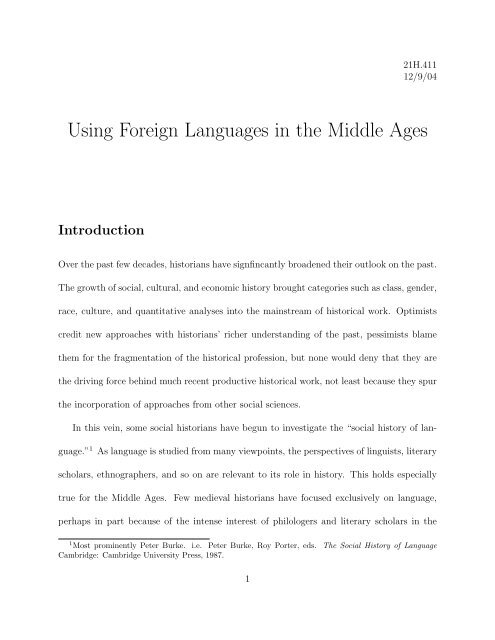
![18.03 Class 21, April 3 Fun with Fourier series [1] If f(t) is any decent ...](https://img.yumpu.com/51148985/1/190x245/1803-class-21-april-3-fun-with-fourier-series-1-if-ft-is-any-decent-.jpg?quality=85)

